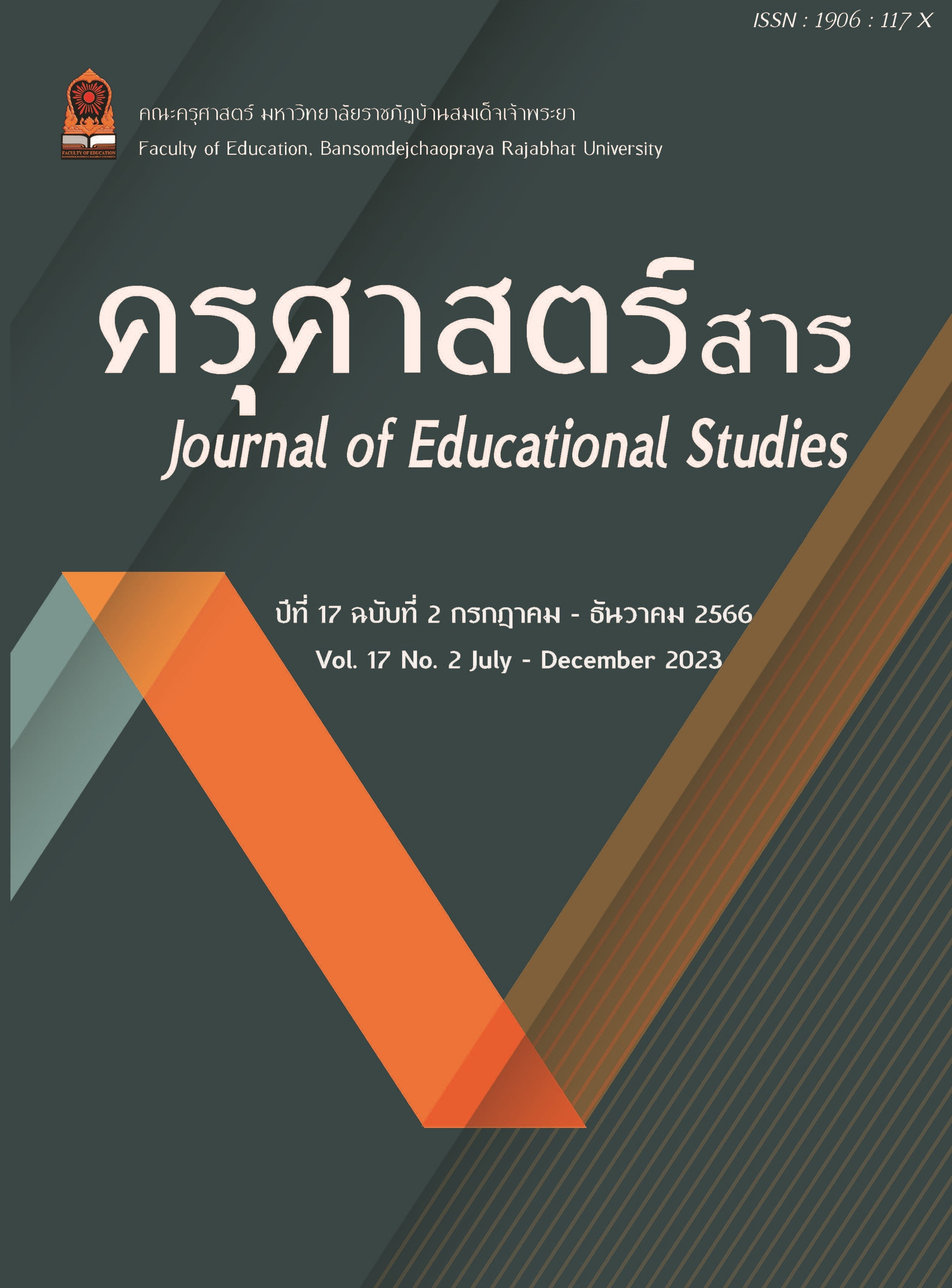Enhance Learning Management Competency with Using Design Thinking Process for Fostering Creative Innovation Ability
Keywords:
Design Thinking Process, Learning Management Competency, Creative Innovation AbilityAbstract
The article aims to present guidelines for enhance learning management competencies of teacher with design thinking process for fostering creative innovation ability of students. Design thinking combination of human-centered, inquiry-based scaffolding and innovation mindsets where students apply knowledge/skill with creative practices to collaboratively discover empathetic insights, generate and explore radical ideas, and create, test, improve tangible outcomes. Design thinking is human-center methodology that providing the tools for students to think and behave like a designer occur in teaching and learning, providing opportunities of best practices to occur in teaching and learning. The teacher design process and thoughtful and reflective of the work being done, how the work is being done, how the work will improve, explore and experiment, build things to learn and think things through. The design thinking process consists of five steps: 1) Empathize 2) Define 3) Ideate 4) Prototype stage and 5) Test
Downloads
References
นภาภรณ์ เจียมทอง และเปรมพล วิบูลย์เจริญสุข. (2566). การจัดการเรียนรู้ด้วยการใช้ความคิดเชิงออกแบบสำหรับนักเรียนประถมศึกษา. Journal of Roi Kaensarn Academi, 8(4), 574-577.
บุญฤดี อุดมผล. (2563). รูปแบบการเสริมสร้างสมรรถนะความเป็นครูเชิงพุทธบูรณาการของนักศึกษาคณะครุศาสตร์ มหาวิทยาลัยราชภัฏ. วารสารการวิจัยการบริหารการพัฒนา,10(2), 161.
ประทีป คงเจริญ. (2564). ทักษะการเรียนรู้และนวัตกรรม: คุณลักษณะสำคัญของพลโลกในยุคเศรษฐกิจที่ขับเคลื่อนด้วยนวัตกรรม. วารสารมนุษยศาสตร์และสังคมศาสตร์มหาวิทยาลัยธนบุรี, 5(3),172 .
ไปรมา อิศรเสนา ณ อยุธยา และชูจิต ตรีรัตนพันธ์. (2560). การคิดเชิงออกแบบ: เรียนรู้ด้วยการลงมือทำ. กรุงเทพฯ: ศูนย์สร้างสรรค์งานออกแบบ (TCDC).
ราชบัณฑิตยสถาน. (2555). พจนานุกรมศัพท์ศึกษาศาสตร์ (ฉบับราชบัณฑิตยสถาน). กรุงเทพฯ: สำนักราชบัณฑิตยสภา.
ราณี จีนสุทธิ์. (2564). แนวทางการพัฒนาครูวิถีใหม่ฉลาดรู้เท่าทันดิจิทัล. ครุสภาวิทยาจารย์, 2(2), 18.
วิจารณ์ พานิช. (2556). การสร้างการเรียนรู้สู่ศตวรรษที่ 21. กรุงเทพฯ: โรงพิมพ์มูลนิธิ สยามกกัมมาจล.
วิชัย วงษ์ใหญ่ และมารุต พัฒผล. (2557). กระบวนทัศน์การโค้ช เพื่อเสริมสร้างทักษะการสร้างสรรค์และนวัตกรรม. กรุงเทพฯ : บัณฑิตวิทยาลัย มหาวิทยาลัยศรีนครินทรวิโรฒ.
วิชัย วงษ์ใหญ่. (2562). การพัฒนาทักษะสร้างสรรค์นวัตกรรม. กรุงเทพ: ศูนย์ผู้นำนวัตกรรมหลักสูตรและการเรียนรู้.
สำนักงานคณะกรรมการการศึกษาขั้นพื้นฐาน. (2553). คู่มือการประเมินสมรรถนะครู สำนักงานคณะกรรมการการศึกษาขั้นพื้นฐาน พ.ศ. 2553. สืบค้นเมื่อ 1 สิงหาคม 2566, จาก http://gpa.tmk.ac.th/teacher/capasity.pdf
สำนักงานเลขาธิการสภาการศึกษา. (2560) แผนการศึกษาแห่งชาติ พ.ศ.2560-2579. กรุงเทพฯ: พริกหวานกราฟฟิค.
สุนันท์ สังข์อ่อง. (2555). หลักสูตรและการสอนสำหรับศตวรรษที่ 21. กรุงเทพฯ: มหาวิทยาลัยธุรกิจบัณฑิตย์.
Brown, T. (2009). Change by Design. New York: Harper Collins Publisher.
Buchanan, R. (1992). Wicked Problems in Design Thinking. Design issues, 82(3): 5-21.
Goldschmidt, G., & Rodgers, P. A. (2013). The Design Thinking Approaches of Three Different Groups of Designers Based on Self-reports. Design Studies, 34(4), 454-471.
IDEO.ORG. (2012). Design Kit. Retrieved August 1, 2023, from http://www.designkit.org/methods/14
Kwek, S. H. (2011). Innovation in the classroom: Design thinking for 21st century learning. Retrieved August 1, 2023, from http://www.stanford.edu/group/redlab/cgibin/publications_resources.php
Lee, D. (2018). Design thinking in the classroom. CA: Ulysses Press. Partnership for 21st century skills. (2009). Professional Development: A 21st Century Skills Implementation Guide. Tucson: Partnership for 21st century skills Organization.
The Stanford d.school Bootcamp Bootleg. (2010). An Introduction to Design Thinking PROCESS GUIDE. Retrieved August 1, 2023, from https://dschoolold.stanford.edu/sandbox/groups/esignresources/wiki/36873/attachments/74b3d/ModeGuideBOOTCAMP2010L.pdf
Downloads
Published
How to Cite
Issue
Section
License

This work is licensed under a Creative Commons Attribution-NonCommercial-NoDerivatives 4.0 International License.
บทความที่ได้รับการตีพิมพ์เป็นลิขสิทธิ์ของคณะครุศาสตร์ มหาวิทยาลัยราชภัฏบ้านสมเด็จเจ้าพระยา
ข้อความที่ปรากฏในบทความแต่ละเรื่องในวารสารวิชาการเล่มนี้เป็นความคิดเห็นส่วนตัวของผู้เขียนแต่ละท่านไม่เกี่ยวข้องกับมหาวิทยาลัยราชภัฏบ้านสมเด็จเจ้าพระยา และคณาจารย์ท่านอื่นๆในมหาวิทยาลัยฯ แต่อย่างใด ความรับผิดชอบองค์ประกอบทั้งหมดของบทความแต่ละเรื่องเป็นของผู้เขียนแต่ละท่าน หากมีความผิดพลาดใดๆ ผู้เขียนแต่ละท่านจะรับผิดชอบบทความของตนเอง


